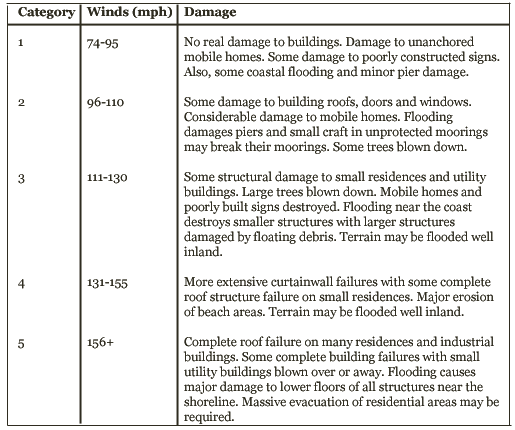
Wind is the mass transport of air caused by pressure variations within the atmosphere. Typically, the lower the barometric pressure, the stronger the winds will be. Measured in terms of velocity, they can range in magnitude from calm (less than 5 mph) to EF-5 tornado strength (greater than 300 mph). In hurricanes, maximum sustained winds can range from 74 to 156+ mph (Saffir, 2010).
On the other hand, winds in Nor’easters rarely exceed 55 mph (McNoldy, Kassawara, & Carter, 2002), but have the propensity to reach speeds upwards of 75 mph (Davis, & Dolan, 1993). Common to all Atlantic coastal storms are the damage caused by waves. As winds flow across the surface of the water, or fetch, they cause a frictional drag force which picks the water up into waves. With strong storms, these waves can develop into storm surges which inundate the coast (see Storm Surges).
In hurricanes, the most common form of damage comes from the winds, though not the most destructive. Most of the personal property damage caused by hurricanes is due to the wind lifting projectiles and throwing them at great speeds. These projectiles can be anything from sign posts to entire roofs. Other types of damage include uprooted trees, toppled structures, broken windows, grounded boats and more (see chart below).
The strongest winds are located in the upper right quadrant of the storm, relative to the hurricane’s trajectory. This is due to the counterclockwise rotation of the storm, backing the momentum of the hurricane into that quadrant. Similarly, the region of fastest winds is around the center of the hurricane called the eye wall. However, within the eye of the storm, winds are relatively calm.
 Nor’easters gain their name from the fact that the winds come from the northeast. Because these extratropical storms form in the middle latitudes and have cold cores, their strongest winds are not near the surface and are not concentrated near the center of the low (McNoldy, Kassawara, & Carter, 2002). Since Nor’easters are larger than hurricanes, sometimes over 1,000 miles across, and usually linger over a region, they often cause more widespread wave induced damage from the increase in fetch (McNoldy, Kassawara, & Carter, 2002).
Nor’easters gain their name from the fact that the winds come from the northeast. Because these extratropical storms form in the middle latitudes and have cold cores, their strongest winds are not near the surface and are not concentrated near the center of the low (McNoldy, Kassawara, & Carter, 2002). Since Nor’easters are larger than hurricanes, sometimes over 1,000 miles across, and usually linger over a region, they often cause more widespread wave induced damage from the increase in fetch (McNoldy, Kassawara, & Carter, 2002).

Photo by Jeff Gammons.
|
Davis, R. E., & Dolan, R. (1993). Nor'easters. American Scientist, 81, 428-439. |
